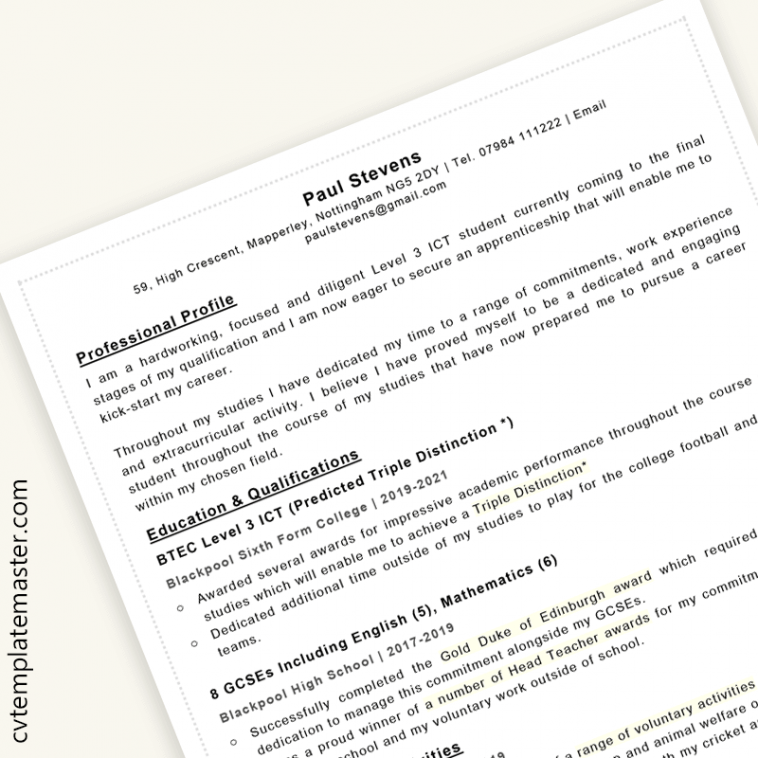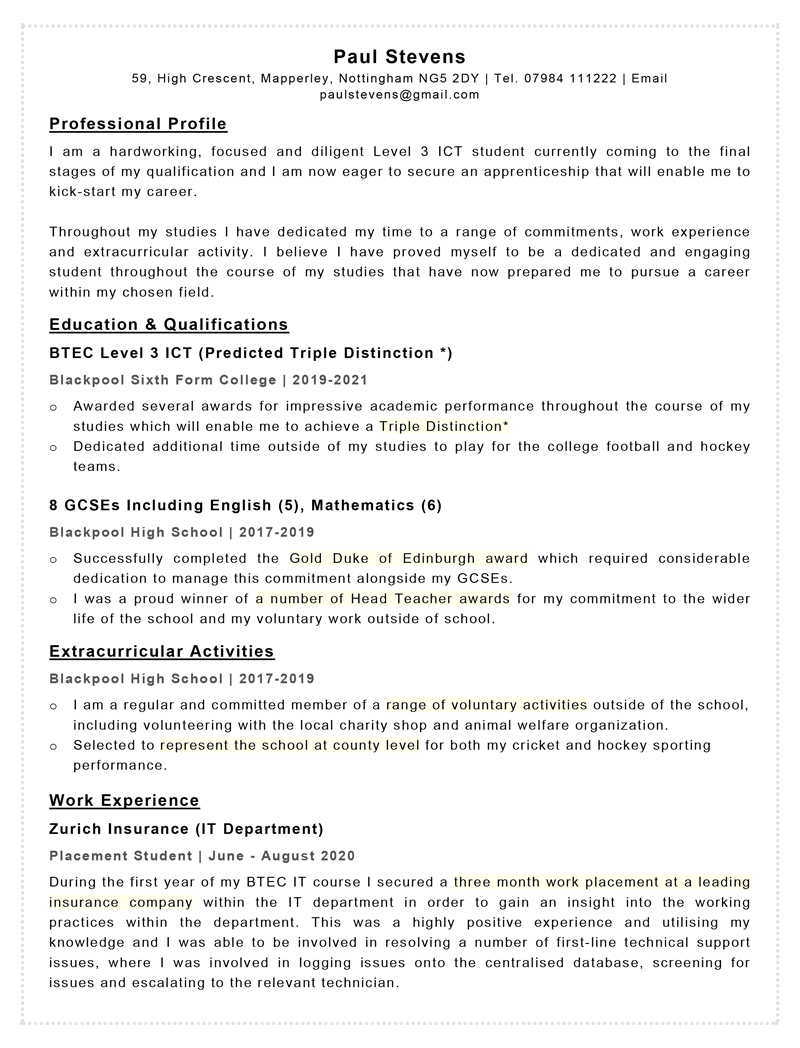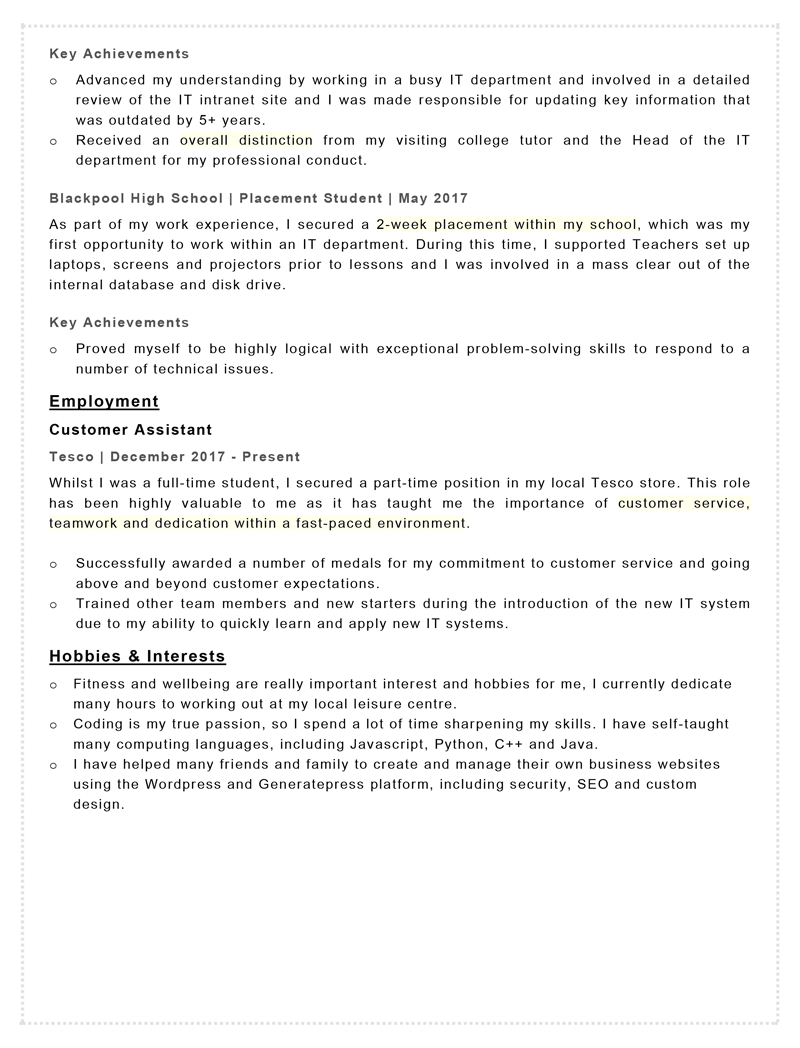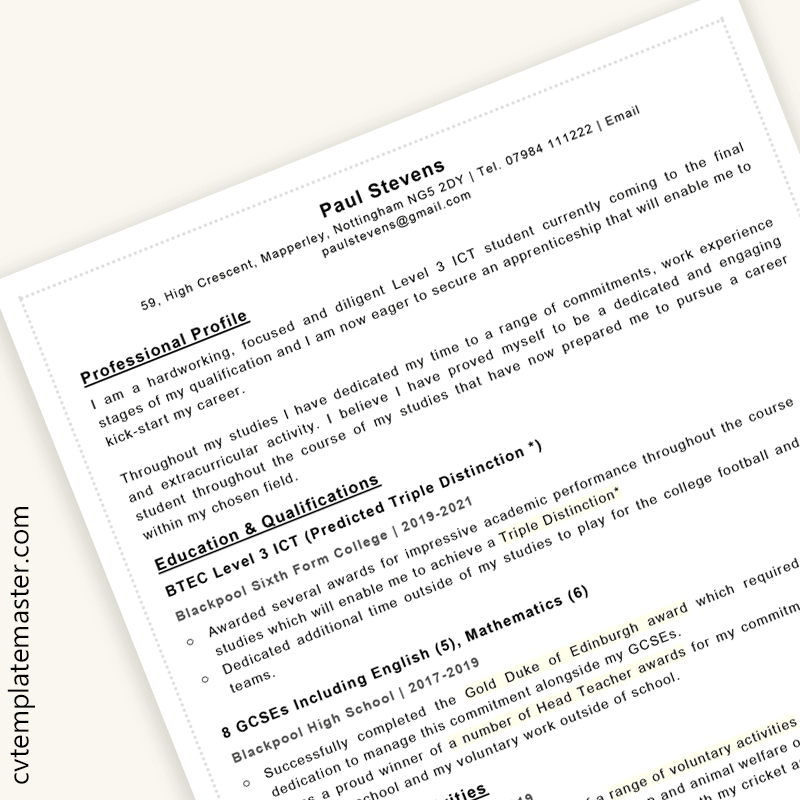Text preview of this CV template:
This is a text-only preview - download the formatted Word file using the link above.
Paul Stevens
59, High Crescent, Mapperley, Nottingham NG5 2DY
Tel. 07984 111222 | Email paulstevens@gmail.com
Professional Profile
I am a hardworking, focused and diligent Level 3 ICT student currently coming to the final stages of my qualification and I am now eager to secure an apprenticeship that will enable me to kick-start my career.
Throughout my studies I have dedicated my time to a range of commitments, work experience and extracurricular activity. I believe I have proved myself to be a dedicated and engaging student throughout the course of my studies that have now prepared me to pursue a career within my chosen field.
Education & Qualifications
BTEC Level 3 ICT (Predicted Triple Distinction *)
Blackpool Sixth Form College | 2019-2021
- Awarded several awards for impressive academic performance throughout the course of my studies which will enable me to achieve a Triple Distinction*
- Dedicated additional time outside of my studies to play for the college football and hockey teams.
8 GCSEs Including English (5), Mathematics (6)
Blackpool High School | 2017-2019
- Successfully completed the Gold Duke of Edinburgh award which required considerable dedication to manage this commitment alongside my GCSEs.
- I was a proud winner of a number of Head Teacher awards for my commitment to the wider life of the school and my voluntary work outside of school.
Extracurricular Activities
Blackpool High School | 2017-2019
- I am a regular and committed member of a range of voluntary activities outside of the school, including volunteering with the local charity shop and animal welfare organization.
- Selected to represent the school at county level for both my cricket and hockey sporting performance.
Work Experience
Zurich Insurance (IT Department)
Placement Student | June – August 2020
During the first year of my BTEC IT course I secured a three month work placement at a leading insurance company within the IT department in order to gain an insight into the working practices within the department. This was a highly positive experience and utilising my knowledge and I was able to be involved in resolving a number of first-line technical support issues, where I was involved in logging issues onto the centralised database, screening for issues and escalating to the relevant technician.
Key Achievements
- Advanced my understanding by working in a busy IT department and involved in a detailed review of the IT intranet site and I was made responsible for updating key information that was outdated by 5+ years.
- Received an overall distinction from my visiting college tutor and the Head of the IT department for my professional conduct.
Blackpool High School
Placement Student | May 2017
As part of my work experience, I secured a 2-week placement within my school, which was my first opportunity to work within an IT department. During this time, I supported Teachers set up laptops, screens and projectors prior to lessons and I was involved in a mass clear out of the internal database and disk drive.
Key Achievements
- Proved myself to be highly logical with exceptional problem-solving skills to respond to a number of technical issues.
Employment
Customer Assistant
Tesco | December 2017 – Present
Whilst I was a full-time student, I secured a part-time position in my local Tesco store. This role has been highly valuable to me as it has taught me the importance of customer service, teamwork and dedication within a fast-paced environment.
- Successfully awarded a number of medals for my commitment to customer service and going above and beyond customer expectations.
- Trained other team members and new starters during the introduction of the new IT system due to my ability to quickly learn and apply new IT systems.
Hobbies & Interests
- Fitness and wellbeing are really important interest and hobbies for me, I currently dedicate many hours to working out at my local leisure centre.
- Coding is my true passion, so I spend a lot of time sharpening my skills. I have self-taught many computing languages, including Javascript, Python, C++ and Java.
- I have helped many friends and family to create and manage their own business websites using the WordPress and Generatepress platform, including security, SEO and custom design.
Template details:

Here’s a full preview of page one of this apprenticeship CV example:

Here’s page two:

How to write an apprenticeship CV
Most employers will expect you to submit a two-page CV for apprentice positions. This should include the following sections:
Name at the top
Just your first name and last name is typical – there’s no need for your title.
Contact information
Provide your address, phone number and email. Avoid using an email address that is unprofessional (e.g. rapstar666@gmail.com).
Only include social accounts if they add value to your CV. For example, you might use LinkedIn to provide further detail on previous work experience or freelancing, or to showcase recommendations and endorsements (find out more here). Include your Twitter handle ONLY if you tweet about industry relevant topics.
Even if you don’t include your social accounts, your public social media profiles must be compatible with the employer’s brand. 54% of employers report that they have eliminated a candidate based on social media. Put yourself in the shoes of the employer – as an employee, would any of your posts be an embarrassment to them, if read by one of their customers? If so, clean up your social accounts before you apply.
If you have a personal website, include it if it showcases anything that would be of value to the employer. It might not necessarily be on topic, but could be used to demonstrate other valuable skills such as strong written communication, adaptability, time management, social media skills, creativity, networking, self promotion and SEO. Alternatively it might be used to showcase some of your portfolio (e.g. programming projects, art and design). As for your social accounts, don’t share your blog address if the content doesn’t add value whatsoever to your application – and consider cleaning up any content that isn’t compatible with your target-employer’s brand.
If the employer has requested a driving licence, make a note of it here (e.g. “full clean driving licence”). If they have requested any other licences such as a forklift licence, mention it here.
Personal statement
Your personal statement for an apprenticeship CV is different from the one you might have written when applying to college or university. It should spell out why you’d be a good candidate for the apprenticeship, addressing any specific requirements set out in the job advert. The statement will be much shorter than a university personal statement – perhaps just 3 or 4 sentences.
Education and qualifications
Normally on a CV this section would come after your work history but on an application for an apprenticeship, it’s typical to include it after the personal statement. Unlike a normal CV, you can also add a little detail into this section, such as any successful projects, good grades, notable achievements awarded or working to difficult deadlines during your studies.
Extracurricular activities
Students rarely have much work experience to include but can instead fill their CV with extracurricular activities. Any notable activities such as volunteering, community projects or involvement with local sports clubs can be included here. These demonstrate valuable soft skills to your prospective employer.
Work experience
If you have worked for any companies without pay, you can include the details in this section. This might be work experience placements or formal voluntary work (such as IT services) for charitable organisations, for example.
You could also include any freelance work you have undertaken here. This might be building websites for family or friends, or selling your services through freelancer sites such as peopleperhour.com.
Employment
If you have any paid employment, include details in this section. Even if it is not directly relevant to the apprenticeship, it demonstrates to employers that you’ve retained a paid role successfully and have therefore developed a range of important skills such as reliability and timekeeping. Try to draw out any particular skills you have acquired that are transferable to your target apprenticeship.
Hobbies and interests
This section can be particularly valuable for an apprenticeship application. Many applicants won’t have a great deal of experience to include on their CV and therefore the personality and attitude of the student plays a more significant part in the decision making process. Employers are looking for hard working enthusiastic candidates with good interpersonal skills and the ability to work in a team. Many hobbies and interests can demonstrate these qualities.
General advice for your apprenticeship CV
Read a job profile for your target role and understand the range of skills that employers value in the industry. Of course, as an apprentice, you won’t have developed all of the hard skills required for the job just yet – but think about what you have already achieved and provide evidence to the employer. Avoid simply claiming that you’re a ‘great teamplayer’ or a ‘hard worker’. Instead, explain how these skills have been acquired. E.g.
“I have played football with the local team for the past 5 years, and I now assist the coach with training the Under 8s team. This has helped me to develop teamwork, perseverance and leadership skills’.
“I volunteered at my local Oxfam store every Saturday for the past six months. The store is always extremely busy and unstaffed so I have put in early starts, a lot of hard work and a willingness to get involved whatever the task. This has been very rewarding as we raise a lot for the charity and I am now used to working under pressure in a busy team. Having good time management, being able to take the initiative and take responsibility have been absolutely essential.”
It’s important to take your time writing your CV and ensure it has no grammatical or spelling mistakes. Get a professional person to proofread the CV before you send it out. Good written communication and attention to detail is incredibly important for almost every job – and mistakes demonstrate the opposite.
Apprenticeship CV FAQs
Do you need a cv for an apprenticeship?
Typically yes - although every employer will have their own requirements, most employers will request a CV to be submitted as part of your application for an apprenticeship.
Can you use your personal statement for an apprenticeship CV?
No - although there may be some crossover, a personal statement for college or university is in a different format to one written for a CV. A CV personal statement should set out why you would be a strong candidate for the apprenticeship role.
You may also find these templates and examples of how to use alternative types of experience on your CV helpful:
Here are some other helpful templates and examples when writing a CV for a work experience placement:
- All student CV templates and guide
- Full guide on writing a CV with little or no experience (lots of examples)
- Example of a CV for a student in university
- School leaver CV template
- CV for teenager: free CV template for a 13, 14 or 15 year old
- Alternative student CV template
- Work experience CV
- Skills based CV
- CV for a part time job (skills based)
NB: This CV template was originally published 11th February 2016 and has been completely updated for 2021.
